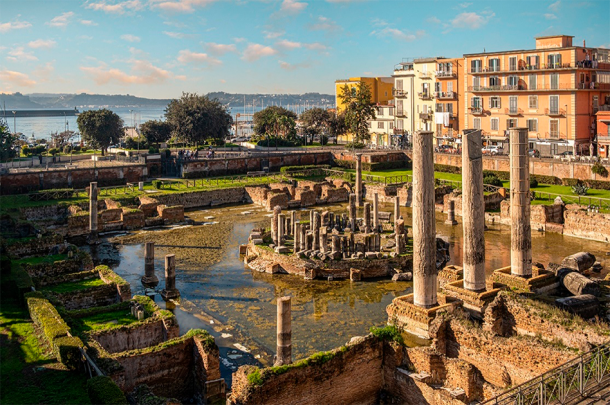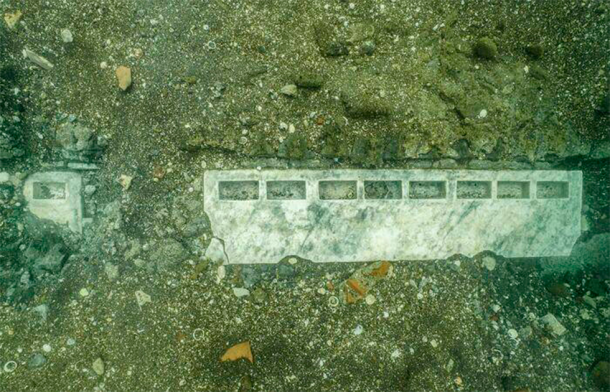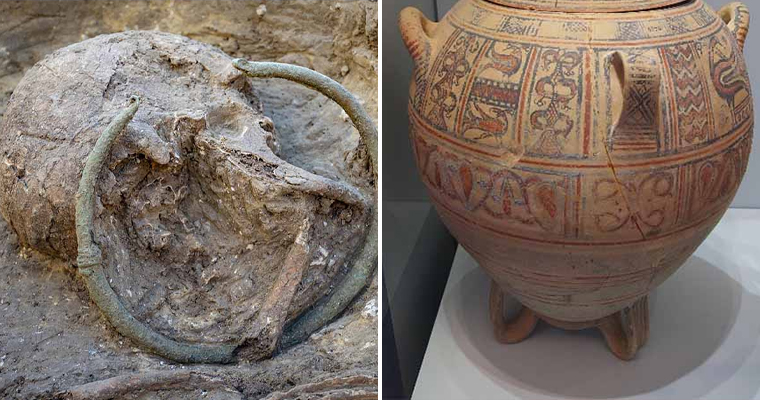Underwater archaeologists searching just off the western Mediterranean coast of the city of Pozzuoli in central Italy discovered the remains of a submerged 2,000-year-old Nabatean temple dedicated to their god Dushara. What they found specifically were two Roman marble altars, which linked the temple to the period when Nabataeans were living freely on the Phlegrean Peninsula 125 miles (200 km) south of Italy’s capital city, in territory fully controlled by the Roman Empire.
The Nabataeans were an Arab tribal group who lived as wandering nomads in the deserts of the Arabian Peninsula in the first few centuries of the first millennium. But once they’d formed enough alliances among themselves to establish their own kingdom, they began to settle down and devote themselves to trade and commerce.
The Nabataean Kingdom formed a voluntary alliance with Rome in the late first century BC, officially launching an association that would last for the next several centuries (although the Nabataeans lost their independence to the Roman Empire in the early second century).
It is known that a thriving community of Nabataeans could be found in the now submerged ancient city of Puteoli, which was located adjacent to modern-day Pozzuoli. During Rome’s Imperial era the Nabataean Kingdom chose to establish a base of operations on the Italian coast, and Puteoli was most attractive to these trade-minded people because it was the largest commercial port in the Roman Mediterranean.
The discovery of the religious complex in the sunken ruins of old Puteoli helps verify that the Nabataeans continued to honor their god Dushara once they’d settled on Roman territory, at least for a time.

The ancient Macellum or market building of the Roman city of Puteoli, where a Nabatean temple has been discovered under the sea. ( Maurizio De Mattei / Adobe Stock)
The Origins and History of the Nabataeans
The Nabataeans first emerged as an identifiable people with an advanced culture between the fourth and second centuries BC. They’d lived in the desert areas of Arabia and the southern Levant for several centuries before this, surviving as an untamed nomadic group that somehow thrived in an impossibly arid environment.
They were known to, and had interactions with, both the Babylonians and the Neo-Assyrian Empire in the first millennium BC. But they were not conquered by either of these kingdoms, protected as they were by an inhospitable desert where others feared to tread.
As they began to increase in population in the third century BC, they formed a loose confederation of various groups that ultimately became the Nabataean Kingdom . This kingdom, which grew prosperous through the vigorous trade networks it created and nurtured in the region, eventually extended its range of control and influence throughout the Arabian and Sinai Peninsulas and deeply into the Levant. Its capital Petra was located in what is now southern Jordan, and that city’s population grew to over 20,000 as a consequence of its development into a major regional trading center.
The Nabataeans were known for their fierceness and determination to remain independent, and they proved to be a tough opponent to defeat in battle. While they initially clashed with the Romans, by the first century AD they’d formed a strong alliance with the Roman Empire, which boosted their commercial prospects and made them more prosperous than ever.
Unfortunately, the Romans proved to be a treacherous ally in the long run. In 106 AD the Roman emperor Trajan sent his armies in to annex all Nabataean Kingdom lands, which he was able to do because the Nabataeans had become less warlike and nomadic, and more settled and focused on agricultural and commercial development, over the past three centuries.
For the first time in 1,000 years, the Nabataean people were no longer independent. Their cultural practices were profoundly impacted by Roman influence from that point on, so much so that they first abandoned their language in favor of Greek, and later rejected Dushara completely when they converted to Christianity.
The Nabateans gained a reputation as a gifted and talented people, with a rich culture and the skills necessary to produce a bounty of attractive goods for trading. Their painted ceramic pottery was especially prized, and was distributed all throughout the region along the trade routes they’d set up. Even after their lands had been seized by Trajan and their kingdom had been turned into the Roman province of Arabia Petraea , the Nabateans continued to dominate trade in the region.

Remains of the Nabatean temple which was discovered underwater in ancient Puteoli. ( The Ministry of Culture of Italy )
Puteoli’s Nabatean Temple: A Legacy Discovered Beneath the Sea
The discovery of the Roman marble altars represents the culmination of a joint archaeological research project that began in late 2021. Underwater archaeologists from two universities in Naples (the University of Campania Vanvitelli and Scuola Superiore Meridionale), supported by the Superintendency of Archaeology, Fine Arts and Landscape for the Metropolitan Area of Naples, have now been searching for artifacts from Roman times in the sunken city of Puteoli ever since.
The latest discovery represents their most exciting find yet. “Ancient Puteoli reveals another of its treasures, which testifies to the richness and vastness of commercial, cultural and religious exchanges in the Mediterranean basin in the ancient world,” declared Italy’s Minister of Culture Gennaro Sangiuliano, in an announcement of the discovery of the Nabataean temple put out by his agency.
This is not the first evidence of the Nabataean presence in Puteoli that has been found. In the 18th century, searchers found an altar and two cult bases while exploring the underwater ruins of the submerged city.
On the bases they found an inscription that identified the site as “Holy to Dushara.” This deity was exclusively worshipped by the Nabataeans, which revealed the truth about their presence in the ancient Roman port city. Further confirmation of Nabataean residency was discovered at around the same time, when archaeologists unearthed a large bust of Dushara near Pozzuoli.
Underwater ruins believed to have belonged to a Nabataean temple were initially spotted in aerial photographs taken in the 1970s. But only with this new discovery has it been possible to place the temple at a precise location in the sunken city, showing where exactly people congregated to worship a god that no other people recognized.
In addition to pinning down the true location of the underwater Nabataean temple, the latest explorations have also enabled the identification of other structures dating to Roman times. This includes warehouses, administrative buildings, smaller structures that served unknown purposes and the axes of roads built inside Puteoli. Conceivably, more Nabataean ruins could be located in the same general area. If they are, future explorations will undoubtedly find them.








